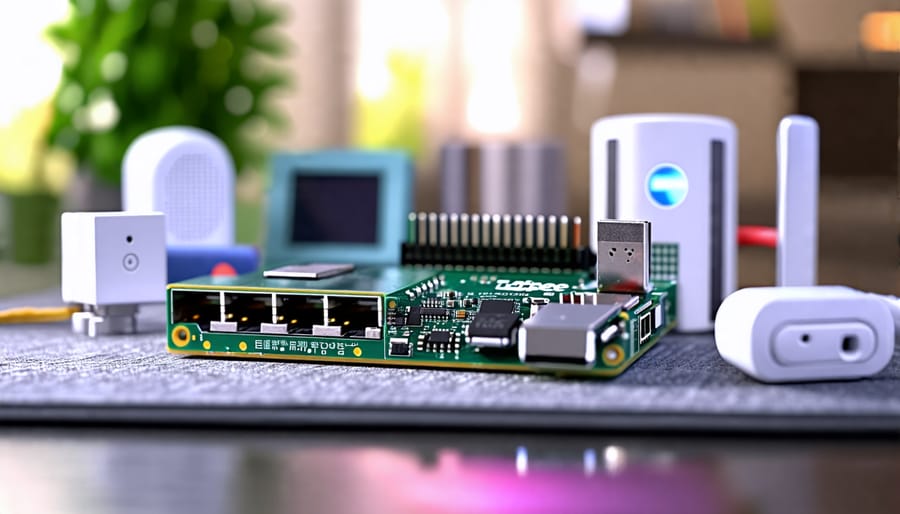Unleash the power of seamless connectivity and automation by integrating Zigbee technology with your Raspberry Pi. Transform your home or workspace into a smart, efficient ecosystem by harnessing the potential of this dynamic duo. Discover how Zigbee’s low-power, mesh networking capabilities perfectly complement the versatility and affordability of the Raspberry Pi, enabling you to create a wide range of innovative IoT projects. From energy-saving smart lighting systems to intelligent security solutions, the possibilities are endless when you combine the flexibility of Zigbee with the power of the Raspberry Pi. Dive in and explore the world of connected devices, where your imagination is the only limit.
Getting Started: Setting Up Zigbee on Your Raspberry Pi

Hardware Requirements
To get started with integrating Zigbee technology on your Raspberry Pi, you’ll need a few essential hardware components. First, choose a compatible Raspberry Pi model, such as the Raspberry Pi 4B or Raspberry Pi Zero W. Next, you’ll need a Zigbee module, like the CC2531 USB dongle or the XBee Series 2C module, which enables your Raspberry Pi to communicate with Zigbee devices. Depending on your project requirements, you may also need additional accessories, such as a breadboard, jumper wires, and sensors. Don’t forget to have a reliable power supply for your Raspberry Pi, as well as a microSD card with sufficient storage capacity to install the necessary software and store your project data. With these hardware components in hand, you’ll be ready to embark on your Zigbee and Raspberry Pi adventure!
Software Setup
To set up your Raspberry Pi for Zigbee integration, start by installing a compatible operating system such as Raspberry Pi OS (previously known as Raspbian). This lightweight and user-friendly OS is optimized for the Raspberry Pi hardware and provides a solid foundation for your Zigbee projects.
Once your Raspberry Pi is up and running, you’ll need to install the necessary libraries and tools. Begin by updating your system packages to ensure you have the latest versions. Open a terminal and run:
“`
sudo apt update
sudo apt upgrade
“`
Next, install the required dependencies for Zigbee communication:
“`
sudo apt install python3-pip python3-dev python3-setuptools python3-wheel python3-pytest git
“`
With the dependencies in place, it’s time to install the Zigbee libraries. One popular choice is the Zigbee2MQTT library, which allows you to use a Zigbee USB dongle with your Raspberry Pi. To install Zigbee2MQTT, run:
“`
git clone https://github.com/Koenkk/zigbee2mqtt.git
cd zigbee2mqtt
npm install
“`
Finally, configure Zigbee2MQTT by editing the `configuration.yaml` file to match your Zigbee USB dongle and network settings. You can find detailed instructions and examples in the Zigbee2MQTT documentation.
With the software setup complete, your Raspberry Pi is now ready to communicate with Zigbee devices. Connect your Zigbee USB dongle, and you can start exploring the exciting world of Zigbee-based home automation and IoT projects using your Raspberry Pi as the central hub.

7 Incredible Zigbee Projects to Transform Your Home
1. Smart Home Lighting Control
Creating a custom Zigbee-based lighting system with your Raspberry Pi is an exciting and practical project. Start by setting up a Zigbee coordinator on your Raspberry Pi using software like Zigbee2MQTT or ZHA. Connect Zigbee-compatible smart bulbs or light switches to your network, and configure them using the coordinator software. Develop a user-friendly interface or integrate with existing home automation platforms to control your lights remotely. With Zigbee’s low power consumption and mesh networking capabilities, you can create a reliable and efficient lighting system. Experiment with different lighting scenes, schedules, and automations to customize your smart home experience. This project not only provides convenient lighting control but also serves as a foundation for expanding your Zigbee-based home automation setup in the future.
2. Energy Monitoring and Management
Harness the power of Zigbee and your Raspberry Pi to create a smart energy monitoring system for your home. By connecting Zigbee-enabled smart plugs and energy meters to your Raspberry Pi, you can track the power consumption of individual appliances and your entire household. Utilize Python libraries like zigbee-HA and home-assistant to collect and analyze energy data in real-time. Set up a user-friendly dashboard using tools like Grafana or Node-RED to visualize your energy usage patterns and identify areas for optimization. Implement automated alerts and notifications to stay informed about unusual spikes in consumption or potential energy-saving opportunities. With this Zigbee-powered energy monitoring system, you’ll gain valuable insights into your home’s energy efficiency and be empowered to make data-driven decisions to reduce your carbon footprint and save on utility bills. Embrace the potential of Zigbee and Raspberry Pi to create a smarter, greener home.
3. Home Security and Surveillance
Transform your Raspberry Pi into a powerful home security hub with Zigbee technology. By integrating Zigbee-compatible motion sensors, cameras, and alarms, you can create a customized surveillance system tailored to your needs. Start by connecting Zigbee motion sensors to your Raspberry Pi, which will detect any movement in your home and trigger alerts. Next, set up Zigbee-enabled cameras to capture live video feeds and store recordings on your Raspberry Pi. You can access these feeds remotely using a web interface or mobile app. Finally, configure your system to send instant alerts via email, SMS, or push notifications when suspicious activity is detected. With a Zigbee-based security system powered by Raspberry Pi, you can enjoy peace of mind knowing that your home is protected around the clock. This project is an excellent way to enhance your home security while learning more about Zigbee and Raspberry Pi integration.
4. Climate Control and HVAC Automation
Zigbee sensors and a Raspberry Pi can be used to automate your home’s climate control and HVAC system for optimal comfort and energy efficiency. By strategically placing Zigbee temperature, humidity, and motion sensors throughout your home, you can gather real-time data about your indoor environment. The Raspberry Pi acts as a central hub, collecting sensor data and using it to make intelligent decisions about when to turn on/off your heating or cooling system, adjust thermostat settings, or control fans and vents. With a well-configured automation system, you can maintain ideal temperatures in occupied rooms while conserving energy in unused areas. Zigbee’s low-power, wireless communication ensures reliable data transmission without the need for extensive wiring. Integrate your Zigbee-Raspberry Pi setup with your existing HVAC system using smart thermostats or relay modules for seamless control. Enjoy a more comfortable home environment and potential energy savings with this powerful automation combo.
5. Smart Garden and Irrigation System
Combine Zigbee technology with your Raspberry Pi to create a smart garden monitoring and irrigation system that optimizes plant growth while minimizing water waste. By deploying Zigbee sensors throughout your garden, you can collect real-time data on soil moisture levels, temperature, and humidity. This information is then transmitted to your Raspberry Pi, which processes the data and makes intelligent decisions about when and how much to water your plants.
To set up the system, connect Zigbee-compatible soil moisture sensors, temperature sensors, and water valves to your Raspberry Pi using a Zigbee coordinator. Develop a Python script that reads the sensor data and controls the water valves based on predefined thresholds. You can also incorporate weather data from online APIs to adjust watering schedules based on forecasted rainfall or extreme temperatures.
By automating your garden irrigation with Zigbee and Raspberry Pi, you can ensure your plants receive the optimal amount of water, reducing waste and promoting healthy growth. This project is perfect for gardening enthusiasts looking to leverage technology for a more efficient and sustainable gardening experience.
6. Voice-Controlled Home Automation
Take your Zigbee-enabled Raspberry Pi to the next level by integrating it with popular voice assistants like Alexa or Google Home. This allows you to control your smart home devices hands-free, making your home automation experience even more convenient. By setting up the appropriate skills or actions in your voice assistant’s app and configuring your Raspberry Pi to communicate with it, you can issue voice commands to turn lights on or off, adjust thermostat settings, or even trigger custom routines involving multiple devices. This integration streamlines your smart home control and showcases the power of combining Zigbee, Raspberry Pi, and voice assistant technologies. With a little setup and configuration, you’ll be able to sit back, relax, and let your voice do the work of managing your connected home.

7. Health and Wellness Monitoring
Harness the power of Zigbee and your Raspberry Pi to create a comprehensive health and wellness monitoring system. By connecting Zigbee-enabled wearable devices, such as fitness trackers or smartwatches, to your Raspberry Pi, you can collect and analyze vital signs, sleep patterns, and activity levels. Set up a dashboard on your Raspberry Pi to display real-time health metrics and generate personalized insights. Configure alerts to notify you of any irregularities or when specific health goals are achieved. With this Zigbee-based monitoring system, you can take a proactive approach to your well-being, making informed decisions to optimize your lifestyle. Whether you’re an athlete looking to fine-tune your training or simply want to maintain a healthy routine, this project empowers you to track and improve your overall health and wellness.
Conclusion
In conclusion, integrating Zigbee with Raspberry Pi offers a powerful and flexible solution for creating custom home automation and IoT projects. By leveraging the low-power, mesh networking capabilities of Zigbee and the versatility of Raspberry Pi, you can build smart, efficient, and scalable systems that cater to your unique needs.
Throughout this article, we’ve explored the benefits of using Zigbee with Raspberry Pi, from its energy efficiency and long-range communication to its compatibility with a wide range of devices. We’ve also provided step-by-step instructions on setting up Zigbee on your Raspberry Pi and showcased seven exciting projects that demonstrate the potential of this combination.
As you embark on your own Zigbee and Raspberry Pi journey, remember that the possibilities are endless. Whether you’re looking to automate your home, monitor your environment, or create innovative IoT solutions, the Zigbee and Raspberry Pi duo has you covered.
We encourage you to explore further, experiment with new ideas, and share your creations with the vibrant Raspberry Pi and home automation communities. By collaborating and learning from one another, we can push the boundaries of what’s possible with these powerful technologies.
So go ahead, get creative, and unlock the full potential of Zigbee and Raspberry Pi in your own projects. The future of home automation and IoT is in your hands!


